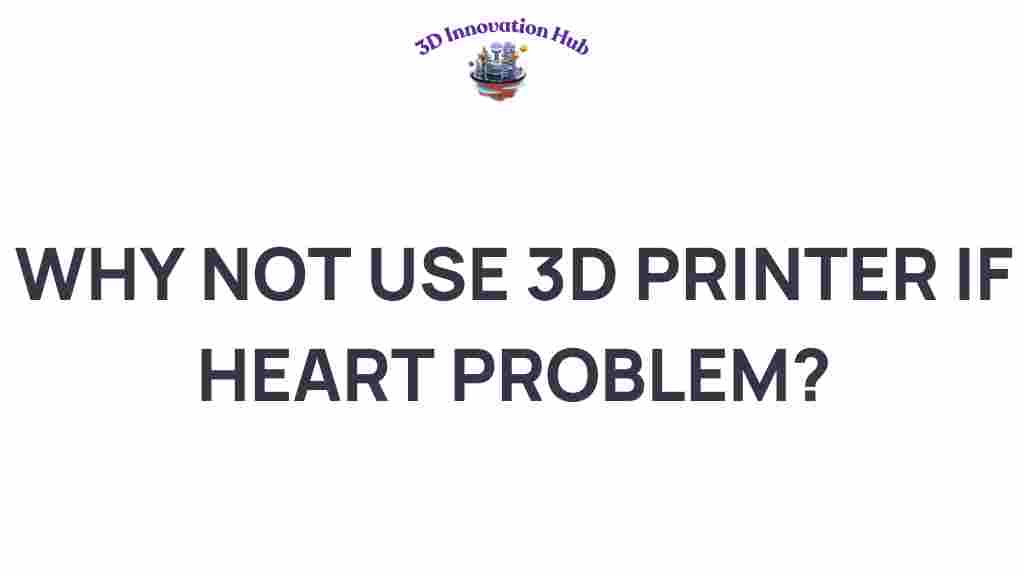Transforming Heart Health: The Revolutionary Role of 3D Printing
Heart health is a critical component of overall well-being, and advancements in medical technology are continually shaping the landscape of cardiovascular solutions. Among these innovations, 3D printing stands out as a transformative force in healthcare technology. This article explores how 3D printing is revolutionizing heart health through personalized medicine, enhancing patient care, and paving the way for new bioprinting techniques.
The Impact of 3D Printing on Heart Health
3D printing, also known as additive manufacturing, allows for the creation of complex structures layer by layer. In the realm of heart health, this technology is being leveraged in various ways:
- Custom Prosthetics: 3D printing enables the production of patient-specific heart valves and stents that fit perfectly within an individual’s anatomy.
- Modeling and Simulation: Surgeons can create accurate models of a patient’s heart, allowing for better pre-operative planning and improved surgical outcomes.
- Bioprinting Tissues: Advances in bioprinting are opening pathways to potentially printing heart tissues for research and regenerative therapies.
How 3D Printing Works in Medical Innovation
Understanding how 3D printing functions is essential to appreciate its applications in heart health:
- Data Collection: The process begins with gathering detailed imaging data from MRI or CT scans of the patient’s heart.
- 3D Modeling: Specialized software converts these images into a 3D model, which can be manipulated to ensure accuracy.
- Material Selection: Different materials are selected based on the application—biocompatible materials for implants, for example.
- Printing Process: The model is printed layer by layer, creating a physical representation of the heart structure.
- Post-Processing: After printing, the models or implants may undergo further treatment to enhance their functionality and longevity.
Personalized Medicine: Enhancing Patient Care
One of the most significant advantages of 3D printing in heart health is its contribution to personalized medicine. Each patient’s heart is unique, and 3D printing allows for tailored solutions that traditional methods cannot provide.
With personalized medicine, treatment plans are customized to fit the individual’s specific needs, which can lead to:
- Improved Compatibility: Customized implants reduce the risk of rejection and complications.
- Enhanced Surgical Precision: Surgeons trained with 3D printed models can perform operations with a higher degree of accuracy.
- Reduced Recovery Times: Personalized treatments often lead to quicker recovery and lower postoperative complications.
Bioprinting: The Future of Cardiac Repairs
Bioprinting represents the cutting edge of 3D printing technology. It involves printing living cells to create biological tissues. In the context of heart health, bioprinting has immense potential:
- Regenerative Medicine: Bioprinting could one day enable the regeneration of damaged heart tissues, offering hope to patients with heart diseases.
- Drug Testing: Printed tissues can be used for testing new cardiovascular drugs, providing more relevant results than traditional methods.
- Research Advancements: Bioprinted models help researchers understand heart diseases better, leading to innovative treatments.
Challenges and Troubleshooting in 3D Printing for Heart Health
While the benefits of 3D printing are clear, several challenges and potential troubleshooting issues can arise:
- Material Limitations: Not all materials are suitable for every application. Research is ongoing to find the right biocompatible materials.
- Technical Expertise: Skilled professionals are needed to handle complex 3D printing systems and ensure safety and efficacy.
- Regulatory Hurdles: The medical field is heavily regulated, and navigating these regulations for new technologies can be daunting.
To address these challenges, healthcare providers must:
- Engage in continuous education on emerging technologies.
- Collaborate with engineers and material scientists to enhance the capabilities of 3D printing.
- Stay informed about regulatory updates and best practices in the field.
Real-World Applications of 3D Printing in Heart Health
To illustrate the impact of 3D printing on heart health, consider the following case studies:
- Custom Heart Valve Replacement: A patient requiring a heart valve replacement received a custom valve made through 3D printing, resulting in a perfect fit and a faster recovery.
- Surgical Planning Models: Surgeons used a 3D printed model of a patient’s heart to plan for a complex surgery, which led to greater surgical success and reduced operative time.
These examples showcase how 3D printing is not just theoretical; it’s a reality that is enhancing patient care and outcomes in cardiovascular medicine.
Conclusion: The Future of Heart Health with 3D Printing
As we look to the future, the role of 3D printing in heart health will undoubtedly expand, offering innovative solutions and personalized care that can significantly improve the lives of patients with cardiovascular conditions. The integration of medical innovation, healthcare technology, and bioprinting heralds a new era in treatment strategies, where patient-specific solutions become the norm rather than the exception.
For further reading on healthcare innovations, visit this resource.
As we embrace these technological advancements, collaboration among healthcare providers, engineers, and researchers will be crucial to unlocking the full potential of 3D printing in transforming heart health.
Explore more about personalized medicine and its impact on healthcare here.
This article is in the category and created by 3D Innovation Hub Team
